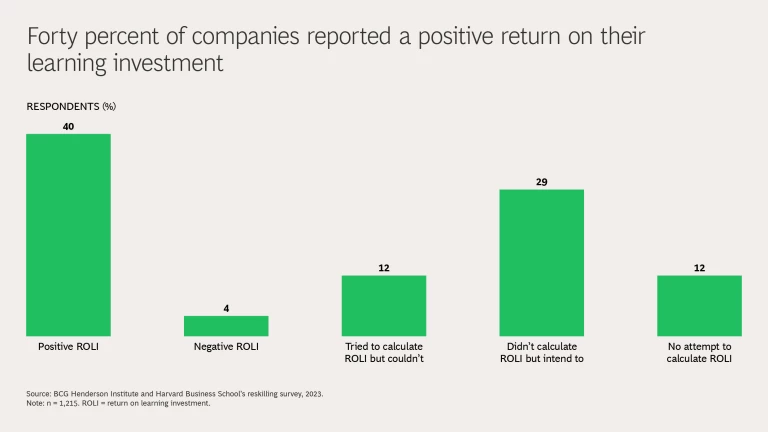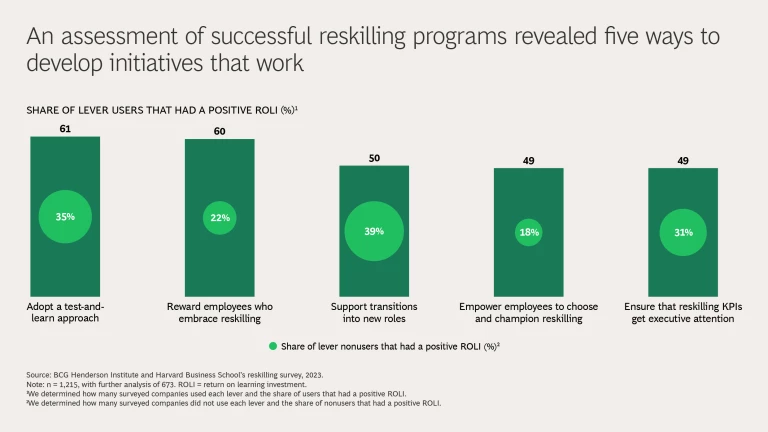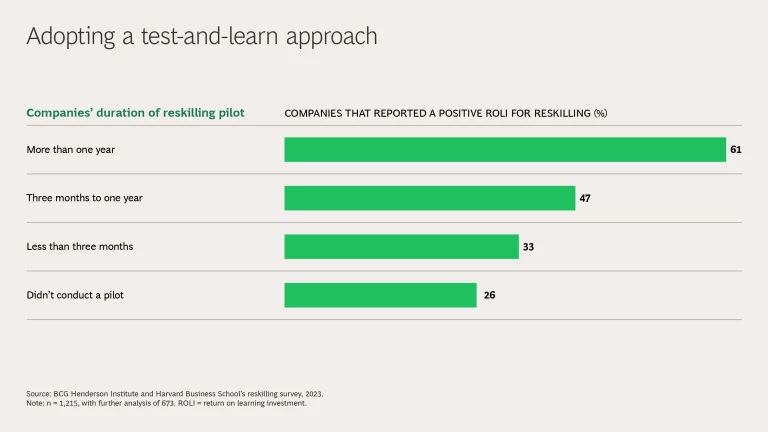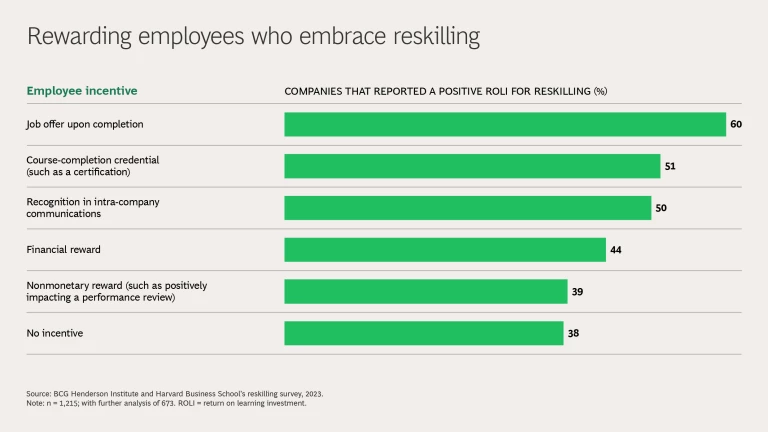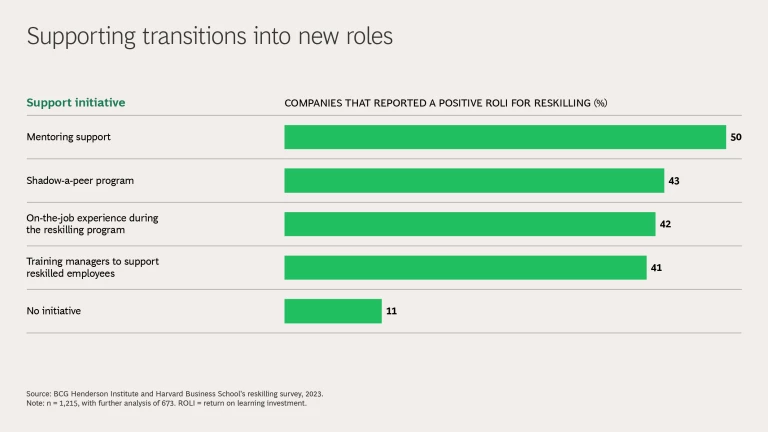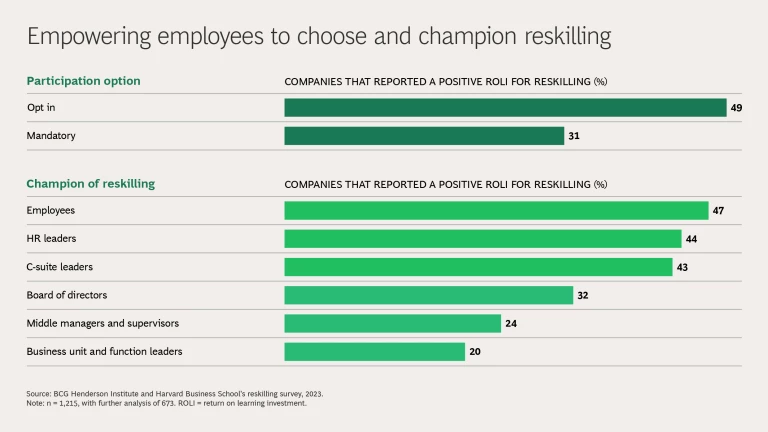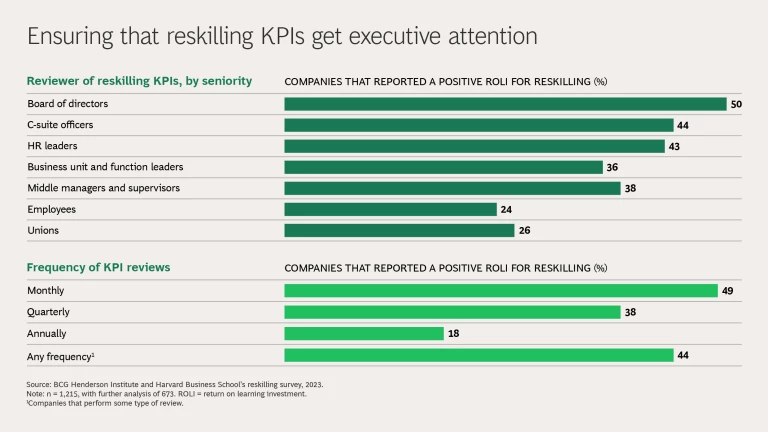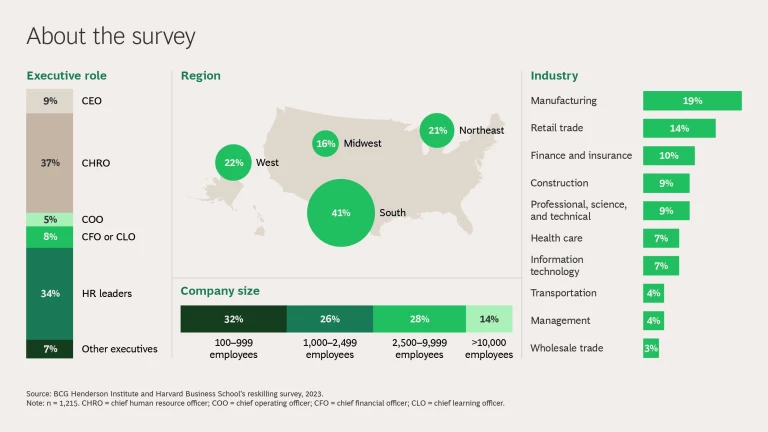The shelf life of a skill is now shorter than ever. Research from the BCG Henderson Institute suggests that by 2030, up to 29% of workers globally—more than 1 billion people—will find that the demand for their job is disappearing. How can people and businesses keep pace?
The answer lies in reskilling, but not all reskilling initiatives are created equal. The BCG Henderson Institute and Harvard Business School surveyed 1,215 US companies that implemented reskilling programs (defined as programs that help employees transition to completely different roles). We also interviewed 40 executives from leading reskilling innovators. Of the companies we surveyed, 40% reported a positive return on learning investment (ROLI) , 4% reported a negative ROLI, and the rest either did not or could not do the calculation.
The fact that 40% of companies are measuring the impact of their reskilling initiative is quite promising. While the impact of skill building in general is notoriously difficult to assess, reskilling programs have a clear, measurable outcome: the people who participate in the program find new jobs. It is therefore possible to compare the costs of reskilling a person with the prospective costs of letting a person go and filling the job through an external hiring process. Our estimates show that this equation turns positive rather easily. However, a certain scale is required to offset the initial investment.
By studying the companies that reported having successful reskilling programs, we identified five ways that can help other companies can achieve a positive outcome.
Adopt a Test-and-Learn Approach
When companies adopt an experimental approach—like they do when launching new products or services—they are more successful at reskilling. In a recent article in Harvard Business Review, we argued that reskilling is more than training—it is a change management exercise that naturally requires early experimentation to get right. Our survey data revealed that of the companies that spent more than one year in a pilot phase—designing, testing, and fine-tuning their reskilling program before scaling it across the organization—61% reported a positive ROLI. Whereas of the companies that didn’t conduct a pilot, only 26% reported a positive ROLI. Clearly, pilots make a difference.
Many of the employers that we interviewed approached reskilling in this careful manner. Several started with cohorts as small 15 to 20 and then refined the concept considerably before scaling up. An
automotive
player had to run a program three times until it got the learning path right and secured the needed buy-in from the affected managers.
Reward Employees Who Embrace Reskilling
Well-designed employee incentives are effective in delivering a positive ROLI for reskilling programs. Our survey shows that the most effective incentive is offering employees a new job upon completion of the program. This reward improves the chances of having a positive ROLI by about 1.5 times over offering no incentive.
However, determining how to guarantee a new job to each employee in a reskilling program is not straightforward. One approach is by adopting diligent, strategic workforce planning that gives leaders a strong understanding of how many open roles there will be and when. Then leaders can ensure that program graduates will have a role to land in. Another approach is to place employees who will be entering reskilling programs in new roles before the training even starts; we call this a place-then-train model. In these cases, participants join their future organizations early so that they begin to shadow colleagues, build networks, and learn on the job before receiving training.
BCG Henderson Institute Newsletter: Insights that are shaping business thinking.
If it is difficult to guarantee a job, the good news is that other incentives also seem to work. The share of companies that reported a positive ROLI was higher among companies that offered “softer” incentives—such as earning course-completion credentials or receiving recognition in intra-company communications—than among companies that did not.
Support Transitions into New Roles
Reskilling programs are incomplete if they end in the classroom; the programs need to ensure that the participants smoothly transition into their new roles. A lack of support at this critical juncture will vastly diminish the reskilling program’s returns.
Companies that reported a positive ROLI for reskilling provided support for employees after retraining them in the form of mentoring, shadow-a-peer programs, and even training for their manager. Such initiatives ensured that retrained employees were able to quickly ramp up to meet the requirements of their new role.
Companies that reported a positive return on their investment in reskilling provided support for employees after retraining them.
For example, Amazon’s Career Choice program supports employees who want to obtain higher degrees and change their occupations. It recognizes that pursuing a major personal and professional change needs additional support, so it partners with Kaplan to support these employees by providing career coaching, college counseling, and career services. A Singaporean bank focuses on ensuring that managers are welcoming retrained employees into their new roles. The bank provides special training for managers to build an open mindset toward reskilled employees and to understand some of the challenges that their new employees may be facing.
Empower Employees to Choose and Champion Reskilling
Organizations that allow employees to opt in to reskilling programs are about 1.5 times more likely to yield a positive ROLI for reskilling over companies that mandate certain employees participate given their function, level, or tenure. Having an opt-in strategy is a clear win-win: the employers spend resources on individuals with the right aptitude and attitude for learning and the employees feel empowered to chart their own course.
Furthermore, companies have a higher chance of a positive ROLI for reskilling when employees advocate for the reskilling program than when it is championed by the C-suite or HR leaders. Interestingly, having middle management and business or function leaders advocate for the reskilling program halves the chances of reporting a positive ROLI—potentially due to middle management being perceived as more resistant to change and employees taking time off for reskilling and moving between teams. This is in line with our findings from interviewing 40 leading reskilling innovators that are actively working on shifting the mindset of middle managers to drive the success of the reskilling efforts.
Ensure that Reskilling KPIs Get Executive Attention
Reskilling programs are complex endeavors—they require robust orchestration and governance across the organization, as well as senior stakeholders who champion the effort and hold others accountable.
Companies that ensure the systematic tracking of reskilling KPIs—with regular monthly reviews by the board of directors and senior executives, including C-suite leaders—are more likely to report a positive ROLI for reskilling. At Ericsson, for example, reskilling KPIs are part of the key results reviewed quarterly by the executive team.
Reskilling is no longer just an optional talent strategy or a step to address the company’s corporate social responsibility goals; it is a business imperative for companies to thrive in a world where talent is a scarce resource.
Increasingly, many employers also see it that way. Even though only 40% of respondents calculated a positive ROLI for reskilling, 88% say they want to continue investing in reskilling anyway. By using these five ways, companies can make the most of their investment.


